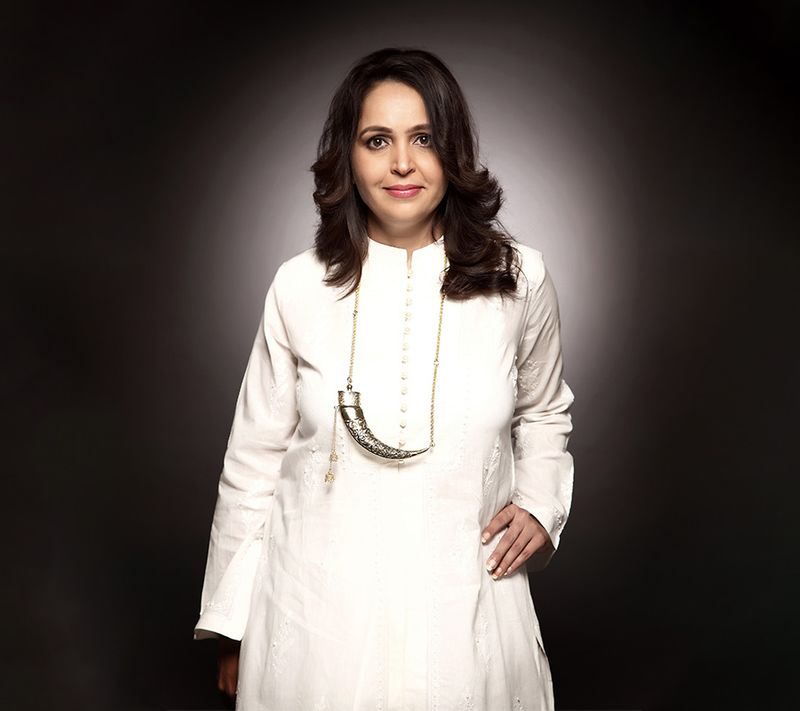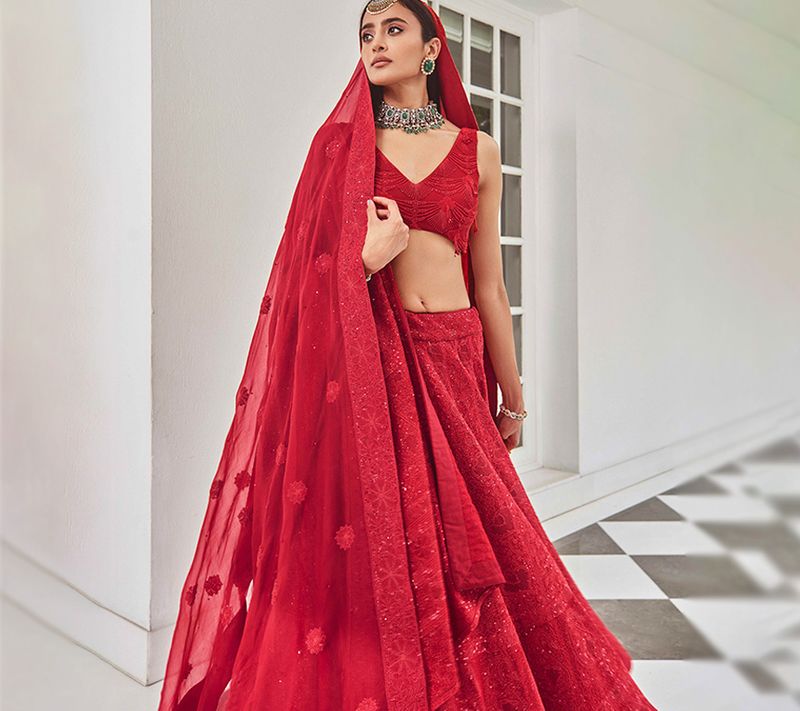The sublime art of chikankari needs no introduction. Derived from the Persian word 'chakin' meaning 'a kind of cloth wrought with needlework', this pristine textile tradition was patronised by the Mughals, particularly emperor Jahangir's wife, Noor Jehan. From then to now – the rich, exquisite embroidery has had its own journey, making its mark from royal courts to fashion ramps.
While the history of chikankari is intriguing, to say the least, its popularity has given way to more commercial techniques in recent times. But not everyone is a part of the bandwagon. There are some like self-taught designer and craft revivalist Anjul Bhandari, who has been consistently working toward the preservation of the ancient art of chikankari. Ever since she started her brand in 2010, her creations have struck the perfect balance between traditional and contemporary design elements, whilst keeping the authenticity of the art alive.

Recently, the couturier launched her latest collection – Surkh Lal. In her own words, "It is the special curation of bold hues, beautiful silhouettes and breathtaking embroideries that speak of a tale imbued in the iconic essence of the historic town of Kannauj." The pieces from this festive range are immaculately hand-embroidered with chikankari threads and Swarovski beads.
In a freewheeling chat, Anjul opens up about her love affair with chikankari, how her brand uplifts artisan communities and the best way for brides to loop in this craft as part of their trousseau.
1. What was your motivation behind taking up chikankari as an art form and working toward its preservation?
When I started out almost a decade ago, it was because my husband hails from the city of Lucknow. I was also hugely inspired by the work my mother-in-law (a social worker) was doing to uplift artisans. I would often accompany her to villages and that's how I got a peek into the lives of artisans. Today, I work directly with these communities and do everything to get the best out of them.
Much before Covid-19 hit, chikankari has been a 'work from home' art. We have been instrumental in opening up various centres in different villages, where five-six girls sit together to work on this art. While working hard on upholding the values of this textile tradition, I also realised that the industry has become very commercial.
The only way to address this was to revive the older stitches that were a part of the ancient art. I want these pieces to be used as heirlooms, and at the same time, provide a sense of security to the artisans.

2. What are some of the prominent stitches in chikankari that we must be aware of?
Due to heavy commercialisation, chikankari pieces are made quickly by local shops. Generally, they use a strand that has 4-5 threads to carry out the embroidery. Imagine doing that with two threads – it's definitely going to take much more time and effort. Our pieces are only done with do taar (two threads), instead of chaar or paanch taar (four to five threads).
There is also a difference in the stitches that are incorporated. Locally-made pieces have 5-6 stitches at best, but our pieces have far more – the needlework is truly exquisite. The revival of stitches is a long-drawn process but we have been trying our best. From do taar, we have moved to ek taar (single thread). One of our most prized creations is the ek taar saree, which is covered with jaal embroidery. It's the most exclusive and exquisite piece you can have in your closet.
3. Since the process is so laborious, how long does it take to create these pieces?
To create one saree in ek taar takes a minimum of 1.5-2 years. There are 5-6 girls who work on a single piece because all of them have to have a similar hand. For instance, if they have to stitch a booti in ek taar, they will take about 1.5-2 days. The work that is locally done in chaar taar takes only an hour, so you can see the difference.
4. Tell us more about the work you have showcased at Sutr Santati that's on at The National Museum, New Delhi.
The piece that has been put up at The National Museum for Lavina Baldota's exhibition is a dupatta with 65 boxes. We have tried to show 65 different kinds of age-old blocks along with two borders. The creation also incorporates a minimum of 20-25 stitches.
5. How do you strike that balance to create pieces that are a crossover between traditional and contemporary?
With social media, there is certainly greater awareness of the rich textile heritage of India. Today, those who come to me, be it, brides or young girls – all of them have already done their homework and know what they want. They are very clear in their head, so I believe half the battle has been won.
Since I only do chikankari or kamdani, my clients want either of the two or an amalgamation of both crafts. What's changed over the years is that people do not want to spend money on anything that they won't use again. Sustainability, heirlooms and reusability are key factors today. I believe it's also much easier now to explain to people how their purchase is supporting artisans.

6. Minimalism is the buzzword for modern Indian weddings, even though brides want to look stylish and edgy on their big day. How can they loop in chikankari as part of their look?
The art of chikankari is a pristine embroidery that doesn't need much talking. Its home, Lucknow, is imbued in varied shades of tehzeeb and nawabi. I believe it's not just a city, but an experience. We try and reflect that emotion in our creations. As a brand, we really make all the efforts to ensure that this art is not worn casually and that's where we try and present it as couture.
I work on pieces that can be classified as the highest couture – the chikankari is further embellished with baby pearls, which are imported from Japan. It is then indigenously dyed with organic dyes. We create our own colour. We have fourth-generation artists who work only by hand. Stitching is the only aspect that is carried out using a machine. My artisans also do turpai (hemming) after stitching.
7. As we know, artisan clusters were heavily impacted during Covid-19. How are you helping them sustain themselves?
Being human is very important to sustain them today – you have to look at their interests before yours. Be it before or after the pandemic, nothing has changed for us. I have never negotiated with an artisan on the price. Since their work is so laborious, I have never had the heart to say that they don't deserve the money. These are people who are keeping our heritage alive and I am ready to pay the price they ask for. That's why we never go on sale or offer discounts to our clientele. When someone supports the brand, they are supporting the artisans. Through the pandemic, even when there were no sales, our work didn't stop for a day.

8. With international designers coming to India to get the support of artisans, is the country’s design industry pressurised to come up with collection after collection?
I believe there was a time when launching four to five collections a year had become common – it all changed to fast fashion. But somewhere during the pandemic, we have learned that it doesn't work like that. Fast fashion is not the way of life; it's the fashion that will help the artisans. Today, 95% of the handloom is done in India, so we are a very sustainable country. Over time, we have realised that it's important to work on our strengths.
International fashion houses taking an interest in India is great and will help us, but I also believe that it should showcase to the world what we are all about. We must not lose our heritage in the bargain.
9. With so many conversations around India's textile heritage today, do you think we are finally getting the attention we deserve?
We are certainly on the right path to prove to the world that we are here to stay!




